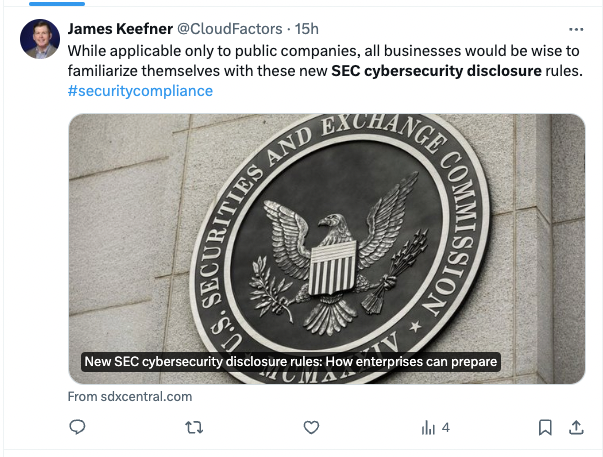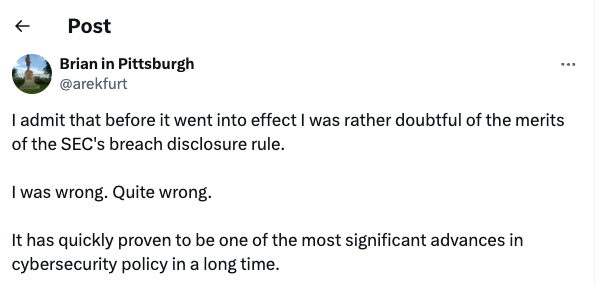The U.S. Securities and Exchange Commission (SEC) has recently implemented new cyber security disclosure rules, marking a pivotal advancement in regulatory standards aimed at enhancing transparency and protecting investor interests.
These rules require public companies to promptly disclose material cyber security incidents and provide comprehensive annual insights into their cyber security risk management practices.
This development comes as a response to the escalating frequency and sophistication of cyber attacks, underscoring the need for clear and timely information to safeguard investor confidence and corporate integrity.
Here’s everything you need to know about the SEC’s new disclosure rules.
TL;DR
|
Aspect
|
Details
|
|
Purpose
|
Enhance transparency and security through standardized disclosures related to cyber security.
|
|
Key Requirements
|
Immediate disclosure of material cyber security incidents; annual reports on cyber security risk management.
|
|
Effective Dates
|
Rules take effect 30 days after publication in the Federal Register; staggered compliance dates.
|
|
Impact
|
Affects all public companies registered with the SEC, enhancing investor insights into cyber security risks and responses.
|
By setting these guidelines, the SEC not only aims to protect investors but also encourages companies to fortify their cyber security frameworks, ultimately contributing to a more secure and resilient market environment.
Overview of the new SEC rules
The newly adopted SEC rules are designed to bolster investor protection through increased transparency in cyber security measures undertaken by publicly traded companies. Key aspects of these rules include:
Purpose
The rules aim to standardize disclosures related to cyber security, enhancing the security and transparency of public entities.
Immediate disclosure requirements
Companies must report material cyber security incidents within four business days of their determination of the incident’s materiality. This prompt disclosure ensures that all stakeholders, including investors and regulators, are timely informed of potential impacts on the company.
Annual reporting
Beyond incident-specific reporting, companies are also required to discuss their cyber security risk management and governance practices in their annual Form 10-K filings. This is intended to provide a more comprehensive view of a company’s preparedness and strategic approach to managing cyber security risks over time.
These guidelines serve not only to protect investors but also encourage companies to strengthen their cyber security frameworks, ultimately contributing to a more secure and resilient market environment.
Key components of the rules
The SEC’s new cyber security disclosure rules are comprised of several critical elements designed to ensure that investors have access to essential information regarding a company’s cyber security status and strategies. Here’s a breakdown of these components:
Immediate disclosure of material cyber security incidents
One of the most significant requirements under the new rules is the obligation for companies to disclose any cyber security incident deemed material within four business days after the incident’s materiality is determined.
This requirement is intended to alert investors and other market participants about significant risks or breaches that could affect the company’s operations or financial health, ensuring that all stakeholders are adequately informed in a timely manner.
Annual cyber security risk management disclosure:
The rules extend beyond immediate incident reporting to include a detailed yearly disclosure regarding a company’s cyber security risk management strategies and governance practices.
This annual disclosure must be included in the company’s Form 10-K filings. The goal is to provide investors with a broader understanding of how companies are preparing for, managing, and mitigating cyber security risks over time.
This includes detailing the roles and responsibilities of management and the board of directors in overseeing cyber security risk management, the frequency of cyber security assessments conducted, and the nature of protective measures implemented to counter identified risks.

These components of the new SEC rules are designed not just to inform but also to enforce a standard of accountability and proactive management that aligns with the best interests of both the companies and their stakeholders. By mandating both immediate and comprehensive periodic disclosures, the SEC aims to cultivate a more secure and resilient corporate environment in the face of growing cyber threats.
The rationale behind the rules
The SEC introduced these new cyber security disclosure rules in response to the evolving landscape of cyber threats that increasingly endanger the financial stability and operational integrity of public companies.
As cyber incidents grow in frequency and sophistication, they pose significant risks not only to the companies directly affected but also to their investors and the broader markets.
Key reasons for the implementation of these rules include:
Increasing cyber threats
The digital age brings numerous advancements and conveniences but also introduces substantial risks. Cyber attacks have become more common and complex, targeting various sectors and compromising sensitive data.
These incidents can lead to significant financial losses, reputational damage, and legal repercussions for the affected companies.
Need for transparency
There has historically been a lack of comprehensive disclosure regarding how companies manage and respond to cyber threats.
Without sufficient information, investors and stakeholders cannot accurately assess the cyber security risk associated with their investments. Enhanced disclosure requirements aim to bridge this information gap.
Enhancing market integrity
By enforcing standardized disclosures, the SEC seeks to improve the overall integrity and stability of the market.
Transparent reporting about cyber risks and incidents helps maintain investor trust and confidence in the market, even in the face of adverse events.
Promoting proactive risk management
The requirement for detailed disclosures not only informs stakeholders but also compels companies to adopt more rigorous and proactive cyber security measures. This can lead to strengthened defenses and a reduced likelihood of significant cyber incidents.
Through these rules, the SEC aims to reduce the information asymmetry between companies and their investors, enhance corporate accountability, and foster a more secure and resilient market environment.

The overarching goal is to ensure that all market participants can make informed decisions based on a clear understanding of the cyber security risks and practices of publicly traded companies.
Implications for public companies
The implementation of the SEC’s new cyber security disclosure rules brings several implications for public companies, driving them towards greater transparency and accountability in their cyber security practices.
This section examines the direct impacts on companies, the challenges they might face, and the potential benefits of compliance.
Enhanced reporting obligations
Increased transparency
Companies are now required to provide detailed information about material cyber security incidents and their risk management practices.
This push for transparency is intended to inform and protect investors, but it also places a greater responsibility on companies to maintain thorough documentation and reporting processes.
Board Involvement and oversight
The rules emphasize the role of the board of directors in overseeing cyber security risk management. Companies must disclose the cyber security expertise of their board members, highlighting the need for boards to be knowledgeable about cyber security threats and defense mechanisms.
Compliance challenges
Resource allocation
Implementing the new rules may require significant resources, including hiring cyber security experts, upgrading IT infrastructure, and enhancing internal controls. Smaller companies, in particular, might find these requirements challenging due to limited budgets and expertise.
Legal and financial risks
Non-compliance or delays in reporting can lead to SEC enforcement actions and potentially severe financial penalties. Moreover, inaccurate reporting can expose companies to lawsuits from investors, further increasing the stakes of compliance.
Potential benefits
Improved cyber security posture
The mandate to report on cyber security governance and incidents can drive companies to strengthen their cyber security measures proactively. This can reduce the frequency and impact of cyber incidents, potentially lowering the long-term costs associated with breaches.
Investor confidence
By demonstrating a commitment to transparency and robust cyber security practices, companies can enhance their reputation and build greater trust with investors. This can be particularly valuable in industries where data security is paramount, such as finance and healthcare.
By adhering to these new requirements, companies not only comply with regulatory expectations but also contribute to a safer, more transparent market environment that benefits all stakeholders.
Future outlook
The SEC’s new cyber security disclosure rules are crucial for companies to adhere to in order to avoid penalties and maximize the benefits of transparent cyber security practices.
Once a company falls within the compliance period, it must begin reporting material cyber security incidents within four business days of their classification as material. Furthermore, annual disclosures about cyber security risk management practices must be included in Form 10-K filings for each fiscal year.

Future regulatory developments
Potential adjustments and updates
As these new rules are implemented, the SEC may refine the requirements based on feedback from companies and the evolving landscape of cyber threats. This could include adjustments to the definitions of material incidents or the specifics of reporting timelines.
Broader regulatory trends
The SEC’s focus on cyber security is part of a broader trend towards increased regulatory scrutiny of digital and cyber risks. Other regulatory bodies, both in the United States and internationally, may adopt similar measures, leading to a more standardized global approach to cyber security risk management and disclosure.
Implications for future corporate strategy
Integration of cyber security into corporate governance
Companies are expected to integrate cyber security considerations more deeply into their corporate governance structures. This includes regular reviews of cyber security policies, more frequent updates to risk management frameworks, and enhanced board oversight.
Technological advancements and cyber security innovations
As the regulatory environment tightens, there will likely be an increased demand for advanced cyber security technologies and services.
This could spur innovation in the cyber security sector, providing companies with new tools and methods to protect their digital assets and comply with regulatory requirements.
Empowering your SEC cyber security disclosure compliance with Vulcan Cyber
Vulcan Cyber offers a comprehensive exposure risk management platform that integrates seamlessly with your existing security infrastructure. By centralizing vulnerability and risk management, Vulcan Cyber enables organizations to streamline their efforts and make more informed decisions about addressing cyber security risks.
In today’s dynamic threat landscape, adhering to stringent regulatory frameworks like the new SEC cyber security disclosure rules is crucial. The advanced features and capabilities of Vulcan Cyber align with SEC requirements and enhance the compliance process.
By aggregating and correlating scanning results, organizations can prioritize cyber security risk effectively and streamline their reporting and remediation efforts, ultimately strengthening their cyber security posture and achieving SEC compliance with confidence.
Start owning your risk today.













